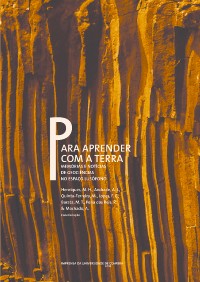Please use this identifier to cite or link to this item:
https://hdl.handle.net/10316.2/31388| DC Field | Value | Language |
|---|---|---|
| dc.contributor.author | Máquina, M. A. | |
| dc.contributor.author | Tavares, A. O. | |
| dc.contributor.author | Henriques, M. H. | |
| dc.date.accessioned | 2014-06-19T14:52:20Z | |
| dc.date.accessioned | 2020-09-18T16:45:31Z | - |
| dc.date.available | 2014-06-19T14:52:20Z | |
| dc.date.available | 2020-09-18T16:45:31Z | - |
| dc.date.issued | 2012 | - |
| dc.identifier.isbn | 978-989-26-0533-3 (PDF) | |
| dc.identifier.uri | https://hdl.handle.net/10316.2/31388 | - |
| dc.description.abstract | The Arco region, located in the Province of Namibe (southwest Angola), corresponds to an integrated area in the Namib Desert, drained by the Curoca River. Configuring a wetland area of great scenic beauty and great tourist interest, its sustainable management is important to be promoted. This paper presents the geological setting and geomorphological evolution of the Arco, which are the source of the peculiar forms that characterize this territory, and the role of the Curoca River in shaping the landscape. The Curoca River, which runs under a torrential regime in a semi‑desert environment, leads to a fluvial and lacustrine system, marked by fluvial deposition and erosion forms and instability mass movements. To this end, we used the interpretation of cartographic data related to 1960, 1987 and 2007, which shows the evolution of drainage and fluvial deposits and bars, lake systems, erosion of the cliffs and badlands. Other landforms associated with erosion were also identified, and representations of the deposition processes and organization of sedimentary bodies are presented. The present study is a contribution to support future measures geoconservation of the Arco, as a region with heritage value of high scenic content, with a view to promoting sustainable development. | eng |
| dc.description.abstract | A região do Arco, localizada na Província do Namibe (sudoeste de Angola), corresponde a um território integrado no deserto do Namibe, drenado pelo rio Curoca, que configura uma zona húmida de grande beleza cénica e com grande interesse turístico, cuja gestão sustentável importa promover. Neste trabalho apresentam‑se o enquadramento geológico e a evolução geomorfológica do Arco, que estão na origem das formas peculiares que caraterizam aquele território, e discute‑se o papel do rio Curoca na modelação da paisagem que, funcionando em regime torrencial num ambiente semidesértico, origina um sistema fluvial e lacustre, marcado por formas fluviais de deposição, de erosão e de instabilidade das vertentes. Para tal, recorreu‑se à interpretação de dados cartográficos que se reportam a 1960, 1987 e 2007, os quais evidenciam a evolução da drenagem e dos depósitos e barras fluviais, dos sistemas lacustres, das arribas de erosão e das badlands. Identificam‑se, igualmente, outras formas de relevo associadas à erosão e apresentam‑se representações dos processos de deposição e organização dos corpos sedimentares. Procurou‑se, com o presente estudo, contribuir para a fundamentação de futuras medidas de salvaguarda da geodiversidade do Arco, enquanto território com valor patrimonial de elevado conteúdo cénico, numa perspetiva de promoção de desenvolvimento sustentável. | por |
| dc.language.iso | por | - |
| dc.publisher | Imprensa da Universidade de Coimbra | por |
| dc.relation.ispartof | http://hdl.handle.net/10316.2/24405 | por |
| dc.rights | open access | - |
| dc.subject | Arco | eng |
| dc.subject | Angola | eng |
| dc.subject | Natural Heritage | eng |
| dc.subject | Geology | eng |
| dc.subject | Geomorphology | eng |
| dc.subject | Arco | por |
| dc.subject | Angola | por |
| dc.subject | Património Natural | por |
| dc.subject | Geologia | por |
| dc.subject | Geomorfologia | por |
| dc.title | O Património Natural do Arco (Namibe, Angola): enquadramento geológico e evolução geomorfológica | por |
| dc.title.alternative | The Natural Heritage oh the Arco Region (Namibe, Angola): geological framework and geomorphological evolution | eng |
| dc.type | bookPart | por |
| uc.publication.firstPage | 251 | - |
| uc.publication.lastPage | 257 | - |
| uc.publication.location | Coimbra | por |
| dc.identifier.doi | 10.14195/978-989-26-0533-3_26 | - |
| uc.publication.digCollection | PB | por |
| uc.publication.orderno | 26 | - |
| uc.publication.area | Ciências Naturais | por |
| uc.publication.bookTitle | Para aprender com a Terra: memórias e notícias de Geociências no espaço lusófono | - |
| uc.publication.manifest | https://dl.uc.pt/json/iiif/10316.2/31388/218673/manifest?manifest=/json/iiif/10316.2/31388/218673/manifest | - |
| uc.publication.thumbnail | https://dl.uc.pt/retrieve/11295624 | - |
| uc.publication.parentItemId | 52123 | - |
| uc.itemId | 71875 | - |
| item.fulltext | With Fulltext | - |
| item.grantfulltext | open | - |
| Appears in Collections: | Para aprender com a Terra: memórias e notícias de Geociências no espaço lusófono | |
Files in This Item:
| File | Description | Size | Format | |
|---|---|---|---|---|
| 26-para_aprender_com_a_terra_v.f..pdf | 727.13 kB | Adobe PDF |  |
Items in DSpace are protected by copyright, with all rights reserved, unless otherwise indicated.
